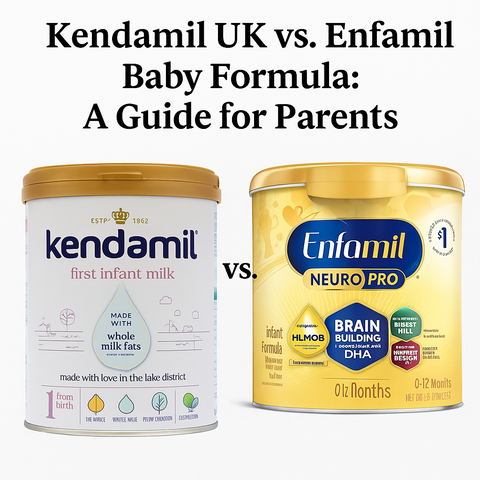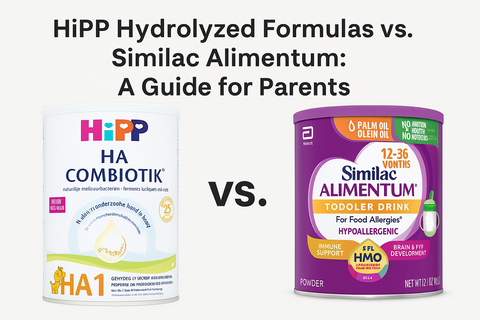Baby Feeding Schedule: A Guide to the First Year and What to Expect
Hospital bag packed, nursery decked out, and loved ones ready and waiting. All systems are “go” and ready to welcome your new baby into your life! There’s just one thing you’re still unsure of: what will a newborn feeding schedule actually look like? You've done your research, talked to friends, and have an idea of how you’d like to handle breast and formula feeding, but you aren’t quite sure you’ve got it right. After all, if you haven’t had a baby before or haven’t fed one, this is a whole new ball game!
Hey, we totally get it! Welcoming a baby brings many new, thrilling, sometimes daunting, and occasionally bewildering experiences. Check out the baby section on various websites, and it might feel like an overwhelming flood of gadgets, nipple options, fancy bottles, and dozens of types of baby formula! Amidst this frenzy of choices, things may seem more complex than they really are.
What you truly need is some guidance on a feeding schedule. You want to know what to expect right from the get-go when your little one arrives all the way through their first year of life. In his article, we'll walk you through some handy breast and formula-feeding tips.
What to expect when your baby comes home
When your bundle of joy finally arrives, It's all about a routine of feeding, sleeping, and, well, the not-so-fun business of diaper changes. Your main goal? Make sure your baby gets the proper feeding at the right times.
Here's the thing: each baby is unique, so their feeding routine will have its own quirks. Eventually, you'll find a way that suits your baby, only to have it change again! Yep, just when you've settled into a pattern, your baby's routine and feeding needs will shift once more. But fear not; this rollercoaster of change is absolutely normal. Staying adaptable is the secret sauce to keeping feeding time successful and joyful.
Recommended Feeding Guide for the First Year
Bringing your little bundle of joy into the world is an incredible experience, and one of your primary responsibilities is feeding your baby. The American Academy of Pediatrics (AAP) suggests exclusively breastfeeding for the first 6 months, followed by continued breastfeeding alongside solid foods for 12 months or more if desired.
Feeding Choices: Breast Milk and Formula
For newborns, breast milk should preferably be their sole source of nutrition. However, when exclusive breastfeeding isn’t feasible, high-quality baby formula enriched with essential vitamins becomes an acceptable alternative for infant feeding. Your priority should be following medical advice and ensuring your baby's health and happiness.
For babies fed with cow's formula or goat's milk-based formulas are suitable alternatives to breast milk for babies under 1 year old, provided there are no allergies or digestion issues. Specialty formulas for sensitive tummies are reserved for cases where cow’s or goat’s milk formulas aren't viable and should be used only under medical advice.
General Guidelines for Feeding
While there are general guidelines for infant nutrition, every baby is unique, and the right amount of food depends on factors like age, weight, and appetite. Consulting your pediatrician helps tailor a feeding guide suited to your child's needs.
Feeding Frequency for Newborns
Newborns have tiny tummies and require frequent feedings day and night. At just 1 day old, their stomach is as small as a marble, accommodating only about 1 to 1.4 teaspoons of liquid at a time. Breastfed babies tend to feed more frequently as breast milk is digested quicker than formula.
Feeding Milestones
From birth to 6 months, breast milk or formula should be the primary source of calories. Between 6 and 9 months, introducing a variety of foods begins as they transition to solid foods. Around 9 to 12 months, their diet evolves, with about half their calories coming from breast milk or formula and the other half from food.
Feeding Chart
The following feeding chart outlines how frequently your baby should nurse and the recommended amount of breast milk or formula based on their age per day. If you ever have doubts about baby feeding guidelines, your baby's healthcare provider is always available to offer guidance.

As your little one crosses the six-month mark, you might notice shifts in their eating habits. This transition phase in feeding can sometimes feel puzzling and overwhelming. To ease this transition and offer guidance, we'll delve into each developmental stage more closely and provide recommendations to bolster your confidence in meeting your baby's nutritional needs, ensuring healthy growth and development.
Guide for Breastfeeding (0 - 12 months)
If possible, breast milk is the gold standard for infants, serving as their primary source of nutrients during the first six months. It’s a remarkable source that adjusts to the baby’s nutritional requirements while delivering antibodies and immunoglobulins crucial for building their immunity. While some mothers naturally produce sufficient milk, others might need time to adjust. It’s important to understand there’s no shame in supplementing breast milk with formula if needed for various reasons.
When commencing breastfeeding, many questions often arise. Initiate breastfeeding during the first skin-to-skin contact with your baby. Initially, the mother’s milk varies in appearance and consistency, with the first milk, known as "Colostrum," being thicker and concentrated, boasting high antibody content vital for the baby's immune system.
Early Stage Breast Milk: Colostrum

After a few days, the milk becomes white, and a feeding pattern takes shape. Here's a general guideline for feeding times:
- 0-1 month: Feed your baby on demand, at least every 2-3 hours, responding to hunger cues like rooting, sucking fists, or crying.
- 1-4 months: Babies may establish a more predictable feeding pattern, aiming for feedings every 3-4 hours.
- 4-6 months: Introduction of complementary solid foods begins while continuing breast milk or formula, feeding every 3-4 hours and offering solids once or twice a day.
- At 12 months, solid foods can become the primary source of caloric intake, and there’s no strict need to maintain a breastfeeding schedule.
Remember, babies may require overnight feedings; respond to their hunger cues in a calm, relaxed setting.
Do Breastfed Babies Need More Vitamin D?

Absolutely! If your baby is primarily or even partially breastfed, your baby's pediatrician will likely suggest incorporating vitamin D supplements into their diet. While human milk is considered an excellent source of nutrients for infants, it often falls short in providing enough vitamin D required for your baby's growth and development.
The American Academy of Pediatrics (AAP) recommends a minimum intake of 400 IU of vitamin D daily, starting in the first few days of life. Vitamin D plays a vital role in helping your little one absorb calcium and phosphorus, which are essential for healthy bone development. This vitamin deficiency can lead to conditions like rickets and compromise bone health.
European Organic Infant formulas from Hipp, Holle, Lebenswert, and Bebe-M are fortified with sufficient levels of vitamin D. Therefore, babies solely bottle-fed generally don't require additional supplements. However, for breastfed babies, incorporating vitamin D supplements becomes crucial to ensure they receive adequate amounts. Before introducing any supplements to your baby's diet, it's essential to consult your pediatrician.
Formula Feeding
Baby formula serves as a specially designed substitute for breast milk, providing essential nutrients crucial for a newborn's growth and development. While breastfeeding is preferred, formula feeding can be a beneficial choice for many parents.
Talking about formula feeding involves understanding the realities many mothers face. Sometimes, external factors are challenging to manage, prompting mothers to seek extra support during feedings. That's where formula becomes a valuable ally.
Support and Convenience in Formula Feeding
Formula feeding allows mothers to get assistance from partners, family members, and caregivers. It's often a necessary solution for mothers juggling work commitments, simplifying travel, and making feeding routines more flexible.
Selecting an appropriate formula aligned with a baby's age and nutritional requirements is crucial. It's equally important to consider any dietary restrictions or special needs when choosing the right formula for the baby. You can check our handy baby formula comparison chart to help you understand the differences between our formulas.
Let's explore what baby formula entails and why some parents opt for formula over breast milk.
Why Infant Formula?
Infant formula is a meticulously engineered alternative designed to mimic the nutritional content of breast milk. Packed with vital nutrients like proteins, carbohydrates, fats, vitamins, and minerals, it is a reliable source of nourishment, supporting a baby's overall well-being. This thoughtfully created formula becomes essential when breastfeeding isn't feasible or preferred.
European Organic Formulas are an excellent option for parents and caregivers who want to feed their little ones with natural, responsibly sourced, top-notch ingredients. These formulas exceed the EU requirements set by the European Food Safety Authority for organic certification, which are much stricter than organic standards in the United States. This ensures it is 100% free from steroids, pesticides, soy, refined sugar, growth hormones, and non-medically necessary antibiotics.
On the flip side, American-made baby formulas might include harmful additives that pose concerns. These can range from synthetic preservatives to artificial flavors and genetically modified organisms (GMOs). These additives might have adverse effects on your baby's health, leading to short-term issues and potentially impacting long-term development, like allergies and chronic illnesses.
Understanding Why Some Parents Choose Formula
At our core, we from Organic Formula Shop believe in open, non-judgmental discussions about why parents might consider formula feeding. Recognizing that a multitude of factors influences this choice is crucial. Here are some reasons:
- Medical Reasons: Certain infants or mothers confront medical conditions that make breastfeeding challenging. In such cases, the formula becomes an excellent alternative for feeding.
- Insufficient Milk Supply: Some mothers struggle with low breast milk production. This makes formula supplementation needed alongside breastfeeding to meet their baby's needs.
- Work or Lifestyle Constraints: The demands of modern life sometimes pose obstacles to breastfeeding. Formula feeding offers flexibility, enabling other caregivers to join in feeding duties.
- Personal Preference: While breastfeeding is recommended, some parents may prefer formula for various reasons, such as personal comfort or establishing a structured routine that aligns with their lifestyle.
Understanding these reasons sheds light on why parents might choose formula feeding. Respecting these choices and supporting families in their unique paths to nurturing their little ones is vital.
Guide for Formula Feeding (0 - 12 months)
Just like breastfeeding babies, it's usually suggested that newborns fed formula should be fed whenever they show signs of hunger, commonly known as feeding on demand. For newborns, feeding typically occurs every 2-3 hours, even if they sleep through the night. Sticking to this schedule is essential to ensure they're getting enough nourishment, even if they don't seem hungry at those times.
Feeding Frequency and Consultation with a Pediatrician
On average, formula-fed newborns consume approximately 8 to 12 times in 24 hours. However, it's crucial to seek guidance from your pediatrician to determine the appropriate amount of formula for your little one. Every baby is unique, and their nutritional needs may differ.
Bonding during Bottle Feeding

Bottle feeding can also be a wonderful opportunity for bonding between you and your baby. Formula-fed babies tend to feel more secure when most of their feedings are given by their primary caregiver, whether it's mom, dad, or another significant person in their life.
You can connect and bond with your baby during feeding time, whether from a bottle. This is your special time to hold your little one close, engage in skin-to-skin contact, talk to them, and create a connection through eye contact.
Feeding Recommendations for Newborns
During the initial days, offering between 1 and 2 ounces of infant formula to your baby every 2 to 3 hours is generally recommended, provided they are not also breastfeeding. As your baby's tummy grows, they'll be able to consume more milk, usually feeding every 3 to 4 hours. You might need to increase the amount by an ounce per feeding each month as your baby grows and their appetite develops.
Regarding formula feeding during the initial three months, it's advised not to stick to a rigid schedule but focus on recognizing your baby's hunger cues. All our formulas include an ENGLISH chart describing the recommended ounces per feeding and preparation instructions. Here's a simple feeding guide based on standard recommendations for portions and schedules:
Remember, this is a general guide, and consulting your pediatrician ensures you meet your baby's specific needs and foster a healthy feeding routine as they grow.
Signs Your Baby Might Need More Milk
Observing certain signs during feeding intervals is essential to ensure your baby gets enough milk. Pay attention to their activity during rest periods to identify hunger cues.
What cues do you need to watch out for?
Baby is hungry if they:
- Smack their lips
- Keep their mouth open
- Make sucking motions
- Root (search for something that strokes their cheek, like a bottle nipple)
- Bring their hand to their mouth
- Move their head from side to side
- Stick out their tongue
- Cry (this is a late sign of hunger)
Baby is full if they:
- Turn their head away from the bottle
- Close their mouth
- Relax their hands
- Don’t seem interested in sucking anymore
- Are fidgety or easily distracted during the feed
- Start to doze off
Remember, all babies respond differently to feeding cues, and it might take some time to recognize these signs. It's common for parents to feel uncertain in the early weeks. However, reaching out to a physician for guidance can be immensely helpful.
Establishing a Feeding Schedule
When establishing a feeding schedule, it's vital to understand that each baby has unique needs. Adjust all recommendations based on your baby's individual requirements. Babies vary in hunger levels, mainly depending on the type of milk they consume. Breast milk and formula can have varying calorie contents, and each baby adjusts according to their metabolic rate and energy intake.
During the initial weeks, a rigid feeding schedule isn't advisable. Research has shown that babies undergo fluctuations in their energy requirements, especially during the early stages. Feeding on cues allows infants to regulate their intake appropriately. Setting feeds too far apart may risk dehydration or inadequate nutrition. Both traditional and Western medicine advise against strict feeding schedules for this reason.
As your baby grows, you'll become attuned to their hunger cues and patterns, making it easier to develop an intuitive feeding schedule known as responsive feeding. Responsive feeding has also been positively linked with less tendency to overeat, less emotional overeating in later stages of life, and reduced risk of being overweight.
Complementary Feedings With Solid Foods
As your baby grows, you might notice their increasing appetite, signaling their readiness to explore the world of solid foods! Organizations like the AAP recommend waiting until your baby reaches 6 months before introducing solids into their diet.
Signs of Readiness for Solid Foods
Around the 6-month mark, babies usually develop the necessary enzymes to handle foods beyond breast milk or formula. However, introducing solids earlier than 6 months can harm your child's health. Signs that your little one might be ready for solids include being excited during mealtimes, wiggling in their high chair, making noises, pointing or grabbing at food, and opening their mouth eagerly at the sight of food.

Apart from these behavioral cues, developmental milestones like sitting up, head and neck control, willingness to eat when offered food, bringing items to their mouth, and improved grasping and swallowing skills are indicators of readiness for solids.
Advice for Introducing Solid Foods
Consult your baby's healthcare provider if you need clarification on introducing solid foods. Many experts recommend baby-led weaning, allowing babies to follow their hunger cues rather than enforcing specific amounts at every meal. This approach encourages healthier eating habits than pressuring your child to finish all their food.
Foods to Avoid and Safe Options

Certain foods should be avoided when starting solids. For instance, cow's milk isn't suitable for babies under 1 year as it lacks necessary nutrients and may strain their kidneys. Fruit juice is discouraged before the first birthday due to its high sugar content, which can lead to tooth decay. In addition, avoid foods high in salt, honey (risk of infant botulism), round candy, hot dogs, popcorn, nuts, seeds, peanut butter, and hard raw fruits/veggies as they pose choking hazards. Also, steer clear of caffeinated beverages for children under 2 years old.
Safe Solid Food Choices
When introducing solid foods, offer one new food at a time and wait a few days between new foods to check for allergies. Healthy choices for a 6-month-old include infant cereal, softly cooked vegetables, fruits, and meats without added sugar or salt. Introducing a variety of foods alongside breast milk or formula helps foster healthy eating habits early on.
Conclusion: Listening to Your Baby's Cues
The world of baby nutrition might seem intimidating at first, but it’s easy to see it as a two-phase plan: first, you start with breastfeeding, formula, or both, and once they hit the six-month mark, you begin introducing solids slowly. It’s important to remember you’ll be responsible for introducing them to the delicious world of food, and you must offer variety and be patient with their process. It is recommended to seek the advice of a qualified practitioner about nutritional requirements.
Contact our dedicated customer support team at Organic Formula Shop for expert advice and guidance tailored to your baby's needs. They have earned hundreds of 5-star reviews from our customers, helping you to provide the best nutrition for your little one. Contact us here or shoot us an email at support@organicformulashop.com. We're here to help!





